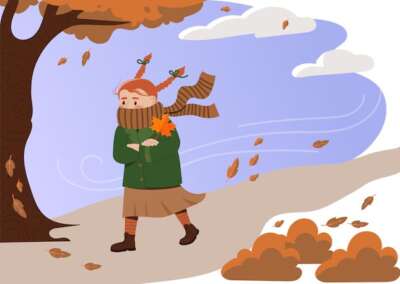
Most of us know how it feels to have our faces slapped by a strong wind or the eerie sensation that arises when it howls so loudly and violently the whole house shakes. But we also know the pleasure of a soothing breeze on a hot day. Wind is not some inherently evil spirit as some may suggest; its impact depends upon the constitution and resiliency of the landscape through which it blows. And, like anything, the value we assign to it depends on the scope and slant of our perspective.
In the ancient metaphysics which inspire and permeate East Asian Medicine (EAM), human beings are understood as elements and incarnations of the natural world. We are a microcosmic embodiment of the Earth, and by extension, the entire universe.
The patterns that transpire in the human body parallel and resonate with those that exist in nature. All forms of being on Earth are simply unique manifestations of the one universal energy or qi. Due to this shared resonance, humans are easily influenced by the outside world, and vice versa. One might say they mirror or mutually engender one another. Rather than a linear model of cause and effect, EAM explains this synchronicity of phenomena through a system of correspondences in which cause is the effect.
From this vantage point, we can better understand the language used in EAM to explain health and disease. States of illness are akin to patterns of poor weather in the landscape of our bodies and are named as such. Often our chaotic internal climate resembles the current external atmosphere, in which case we might say that we have been impacted by an external influence, such as wind, cold and dampness. These influences can be both the cause of disease and serve as names for patterns of stress in the body.
The most virulent of the climatic forces that create disharmony in the human body is wind. It, like all the external influences, is seen as both the cause and the effect of disease. Wind is considered the spearhead of all disease, for it serves as a vehicle to carry other undesirable Influences into the body. But it’s worth noting, that with a shift in perspective, wind can also be regarded as the spearhead of all growth.
A disorder that Western medicine deems unexplainable, may be thought of as a wind condition in EAM. Wind can invade the body from the outside (external wind), predominantly disturbing the lung qi or be generated internally (internal wind), where it primarily agitates the liver qi. When we are vulnerable, external wind often penetrates the body through the back of the neck, so wearing a scarf and staying bundled up in windy weather can help keep us well. Once wind has entered the body, herbal formulas and acupuncture treatments can help to release it and harmonize the qi to prevent future disruptions.
Wind is a contributor to such disorders as colds, influenza, spasms, tremors or seizures, migratory diseases like arthritis, certain skin disorders, dizziness and pain. Symptoms that come and go or move around are attributed to wind. Headaches that come and go, rashes that move around and allergy symptoms may all be caused by wind. Wind is responsible for itchy sensations. Itchy rashes, itchy nose and eyes, dry itchy skin are all signs of wind. Certain types of cough are wind related. Pathogenic wind cold is the Chinese equivalent of the common cold.
Wind has an upward movement, often causing problems in the head and face. Bell’s Palsy and other types of paralysis may be wind trapped in energetic channels blocking circulation. Hypertension can lead to pathogen wind symptoms. Most pathogenic wind conditions are not life threatening, but some are disabling. In EAM, stroke is considered to be an extreme rushing up of internal wind into the brain.
Of all the pathogenic influences or climates that can invade our bodies, wind is one of the easiest to treat. Acupuncture works wonders in the beginning stages of a cold or for allergy symptoms caused by wind. The needles quickly restore an energy flow that settles wind, extinguishing it from the body. Cupping therapy is another invaluable tool in treating pathogenic wind. The suction of the cups draws the wind to the surface, where it is expelled through the pores. Cupping is frequently used for muscle aches and wind-related respiratory problems. There are also many Chinese herbal remedies formulated to disperse wind.
So the next time you start feeling the twitch of a cold, allergies or even chronic muscle spasms, consider scheduling an acupuncture session. It could keep things from getting worse and get you back on track quickly.

